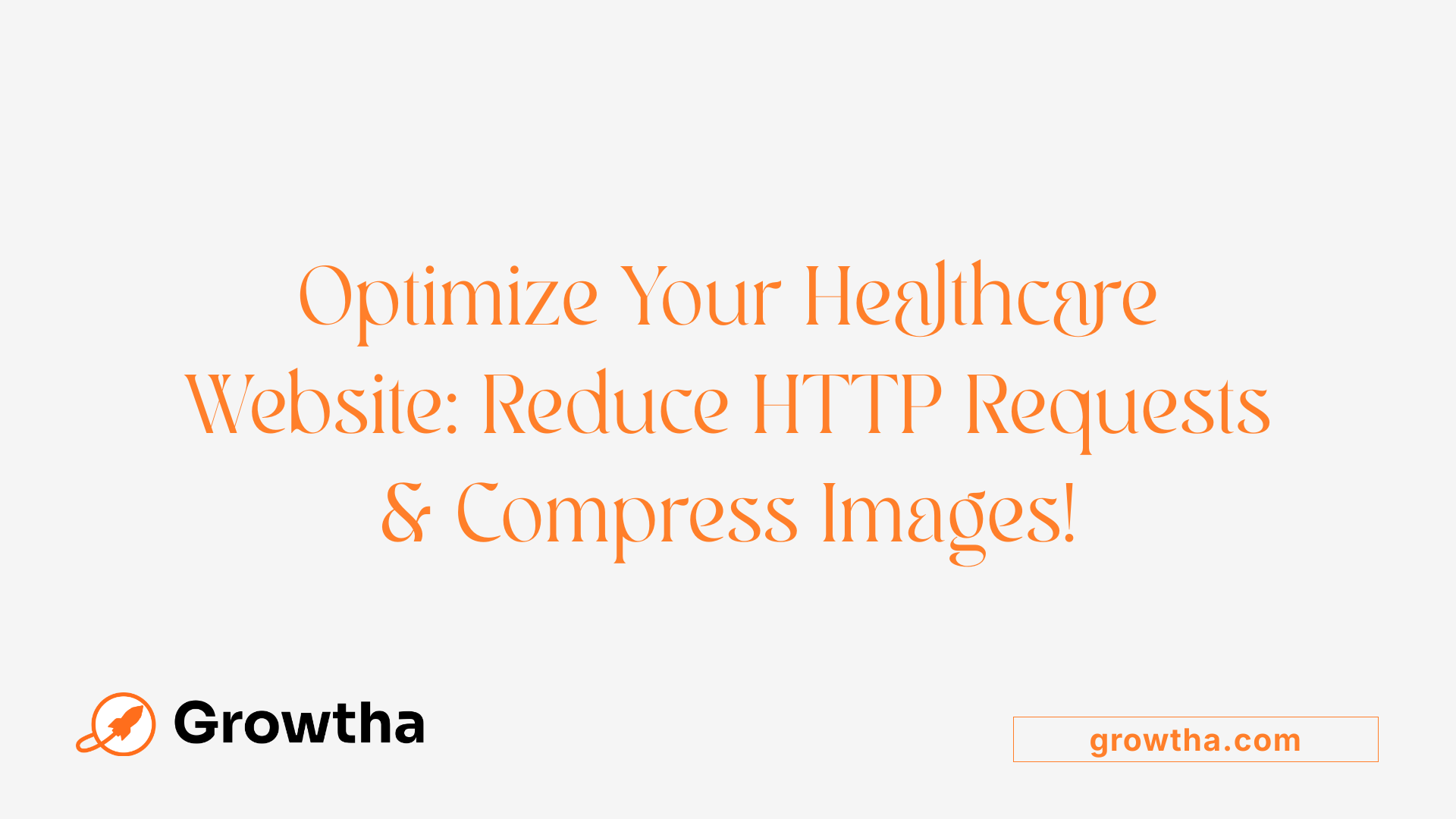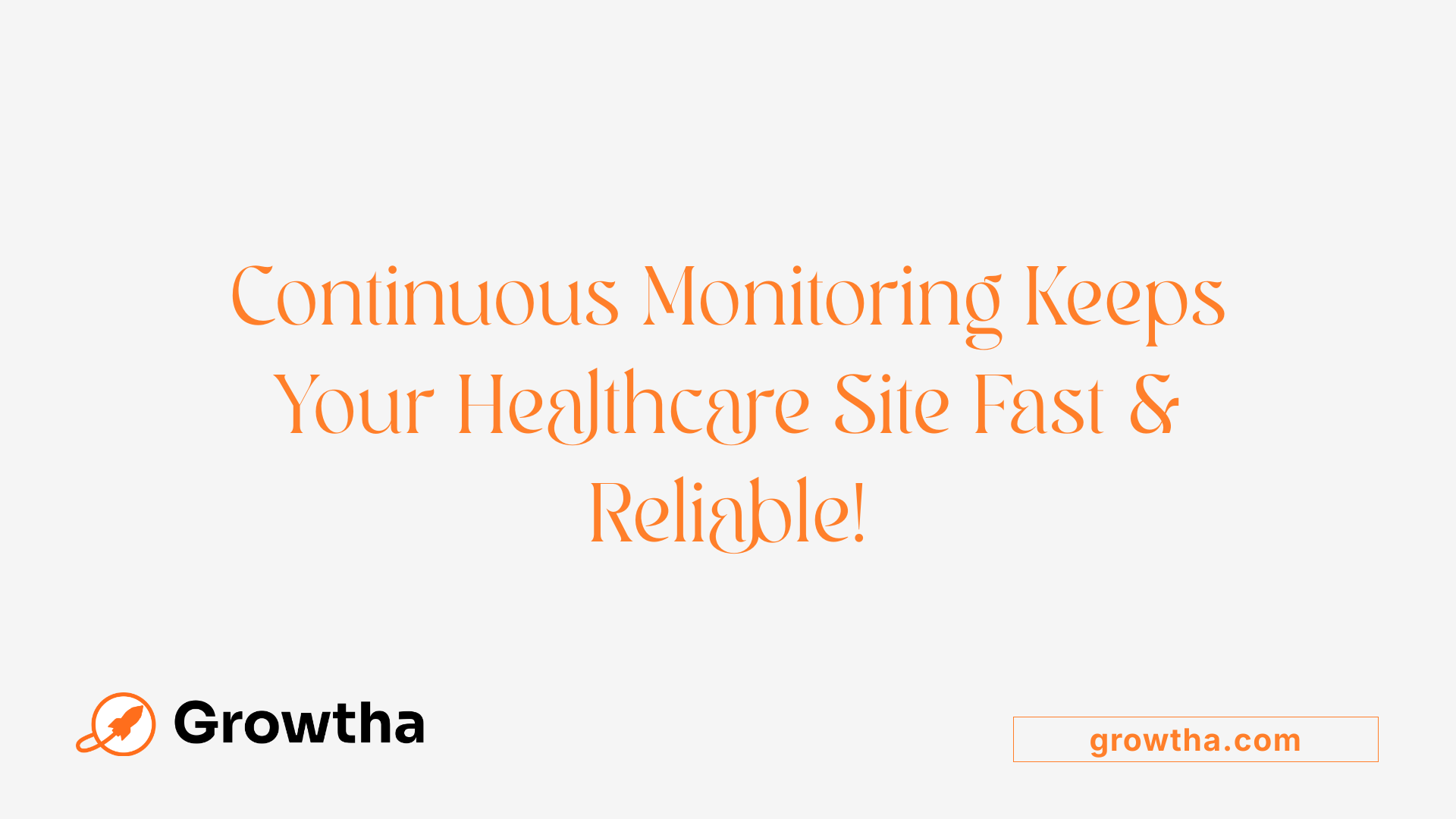Strategies for Improving Mobile Site Speed for Medical Websites
Optimizing Mobile Performance in Healthcare Websites for Better Patient Outcomes


Strategies for Improving Mobile Site Speed for Medical Websites
Understanding the Critical Role of Mobile Site Speed in Healthcare
In today’s digital age, mobile device usage continues to soar, particularly for healthcare information seeking. For medical websites, ensuring rapid load times and optimal performance on mobile devices is essential to attract, retain, and serve patients effectively. This comprehensive guide explores the strategies, best practices, and tools necessary to enhance mobile site speed, improve SEO rankings, and provide a seamless patient experience.
Fundamental Factors Influencing Mobile Site Speed in Healthcare

What are the key factors affecting website speed in healthcare?
Website speed is vital for healthcare providers aiming to retain patients and provide seamless access to medical information. Several interrelated factors influence how fast a healthcare website loads, especially on mobile devices.
One of the primary elements is the number of HTTP requests. Each resource—such as images, scripts, and stylesheets—requires a separate request to the server. Too many requests can slow down load times, so minimizing these is crucial.
Server processing times also play a critical role. If the hosting server takes too long to process requests, the entire page load can be delayed. Choosing reliable, high-performance hosting plans can help reduce this bottleneck.
Images are often resource-demanding. Large image files, especially if not optimized, can significantly increase page size and load time. Compressing images and using appropriate formats ensures quicker display without sacrificing quality.
Finally, inefficient or bloated code can hamper loading speeds. This includes unnecessary scripts, inline styles, or poorly written JavaScript. Streamlining and minifying code, as well as loading scripts asynchronously, can improve overall performance.
Focusing on these factors—reducing HTTP requests, optimizing server processing, compressing images, and cleaning up code—can greatly enhance the speed of healthcare websites on mobile devices. This not only improves user experience but also positively impacts search rankings and patient trust.
For more detailed insights, searching "Key factors influencing mobile site speed for medical websites" provides additional strategies to optimize healthcare web platforms.
Leveraging Performance Measurement Tools for Continuous Optimization

What tools can help improve mobile site speed in the medical sector?
Ensuring fast and efficient mobile websites is essential for healthcare providers aiming to retain visitors and provide an optimal user experience. Tools like Google PageSpeed Insights, WebPageTest, and Pingdom are instrumental in assessing website performance, identifying aspects that may hinder speed.
Google PageSpeed Insights offers insights specifically tailored for both desktop and mobile versions, analyzing aspects such as load times, image optimization, and server response times. This tool provides actionable suggestions to enhance site performance.
WebPageTest allows detailed, multi-browser testing, delivering comprehensive reports on various performance metrics, including Time to First Byte (TTFB), First Contentful Paint (FCP), and Largest Contentful Paint (LCP). It also shows how different network conditions impact site speed.
Pingdom provides user-friendly dashboards for monitoring website uptime, performance, and page analysis, highlighting issues like resource loading times and broken links.
By regularly utilizing these tools, healthcare organizations can precisely pinpoint factors affecting mobile site speed, from large image files to excessive HTTP requests. Continuous analysis facilitates targeted improvements, ensuring faster load times, better search engine rankings, and improved patient engagement.
Investing in ongoing performance evaluation with these tools supports the overall health of a medical website, ensuring it remains accessible, efficient, and trustworthy to users and search engines alike.
Best Practices for Optimizing Mobile Healthcare Websites

What are best practices for optimizing healthcare websites for mobile devices?
To ensure healthcare websites perform well on mobile devices, a combination of strategic design and technical optimization is essential.
One of the most important approaches is adopting a responsive design. This means creating a website that automatically adjusts its layout to fit various screen sizes and device types. A mobile-first approach ensures the site is optimized for small screens from the outset, enhancing usability and accessibility.
Optimizing image sizes plays a crucial role in speed improvement. Compressing images reduces load times significantly, which is vital as over 60% of searches occur on smartphones. Minimize HTTP requests by reducing unnecessary scripts and stylesheets, making the site faster.
Leveraging caching techniques allows frequently accessed data to be stored locally on users' devices. This reduces server load and speeds up subsequent visits. Implementing Content Delivery Networks (CDNs) spreads content across multiple servers worldwide, decreasing latency and improving load times globally.
Besides technical tweaks, simplified and intuitive navigation makes it easier for users to find critical information quickly. Clear menus, large clickable buttons, and minimal clutter enhance the user experience.
By integrating these practices—responsive design, optimized images, caching, CDNs, and straightforward navigation—healthcare providers can deliver a fast, reliable, and user-friendly experience for mobile visitors, directly impacting patient engagement and satisfaction.
Technical Tips for Enhancing Mobile Site Speed

What technical tips can improve mobile site speed for healthcare websites?
Mobile site speed is crucial for engaging patients and improving search engine rankings. There are several technical strategies healthcare providers can implement to boost their mobile website performance.
One essential tip is image optimization. Using modern formats like WebP or AVIF significantly reduces image file sizes without sacrificing quality, allowing pages to load faster and reducing data usage for users.
Reducing HTTP requests is another effective approach. This can be achieved by minimizing the number of scripts, stylesheets, and plugins on the site. Combining files, removing unnecessary ones, and streamlining code help decrease load times.
Leveraging browser caching allows repeat visitors to experience quicker page loads. By setting proper cache headers, browsers can store static resources locally, avoiding the need to re-download them on each visit.
Implementing Accelerated Mobile Pages (AMP) can also dramatically improve load speeds. AMP creates simplified, lightweight versions of web pages specifically designed for fast mobile browsing, which can enhance user experience and potentially boost rankings.
Additionally, choosing a reliable, fast content delivery network (CDN) ensures content is served from servers closest to the user, reducing latency. And selecting a high-performance hosting plan tailored to healthcare websites assures optimal server processing times.
Adopting these practices helps create a seamless mobile experience, retains visitors longer, and improves overall site effectiveness.
| Technique | Description | Benefits |
|---|---|---|
| Image Optimization | Use WebP or AVIF formats for smaller images | Quicker load times, less bandwidth usage |
| Reduce HTTP Requests | Minify code, combine files, remove unnecessary scripts | Faster page rendering |
| Browser Caching | Store static resources locally on the browser | Quicker revisit experiences |
| AMP Implementation | Develop lightweight, fast-loading mobile pages | Improved load speeds, higher rankings |
| CDN and Hosting | Use CDN and choose optimized hosting | Reduced latency, better scalability |
Regularly updating these practices is vital to maintaining a swift, user-friendly healthcare website that meets the expectations of mobile users and search engines alike.
SEO Strategies for Boosting Mobile Performance and Visibility
What SEO strategies can enhance the mobile performance of medical websites?
Improving mobile SEO requires a combination of technical and content strategies that ensure fast, user-friendly, and authoritative websites. First, optimizing page speed is crucial. Compressing images and leveraging browser caching reduce load times, which is vital since over 40% of users abandon pages that load in more than three seconds.
Responsive design is essential for mobile usability. A mobile-first approach ensures that the website adapts seamlessly to various screen sizes, providing users with a smooth experience. Avoiding intrusive pop-ups and simplifying navigation help keep visitors engaged.
Implementing schema markup, such as LocalBusiness or MedicalEntity schema, helps search engines better understand your site content, leading to enhanced rich snippets and higher visibility.
Local SEO strategies also play a significant role. Creating and optimizing Google My Business profiles, ensuring NAP consistency, and using local keywords help attract nearby patients searching for healthcare services. Encouraging and managing patient reviews further boosts credibility.
Lastly, producing high-quality, authoritative content that is regularly updated, relevant, and trustworthy builds trust with both users and search engines. Clear credentials, expert-authored articles, and comprehensive service information contribute to high E-A-T scores, which are critical for medical sites.
By focusing on these areas—speed, responsiveness, structured data, local presence, and content quality—healthcare providers can enhance their mobile performance, improve search rankings, and deliver a better patient experience.
Actionable Tips for Improving Mobile Load Times
What actionable tips can be used to optimize healthcare websites for faster mobile load times?
To make healthcare websites load faster on mobile devices, several practical steps can be taken. First, adopting a responsive design ensures that your website automatically adapts to different screen sizes, providing a seamless user experience.
Next, compress images using modern formats like WebP or AVIF, which significantly reduce file sizes without sacrificing quality. This decreases the amount of data that needs to be loaded, speeding up page appearance.
Reducing HTTP requests is also crucial. Minimize the use of scripts and eliminate unnecessary plugins or elements that can delay page rendering. Combining CSS and JavaScript files can further decrease the number of requests made by the browser.
Using Content Delivery Networks (CDNs) can help distribute content geographically, bringing resources closer to users and reducing latency. This is particularly effective for healthcare websites serving a broad or regional audience.
Finally, optimize server configurations by implementing HTTP/2 and utilizing SSD hosting. These improvements allow for faster data transfer and quicker server responses, directly impacting load times positively.
Applying these steps will dramatically improve mobile load speeds, providing a better experience for patients and visitors, and supporting higher search engine rankings.
Role of Monitoring and Analytics in Sustaining Mobile Performance

How can healthcare providers maintain optimal mobile site speed?
Maintaining fast mobile websites is essential for healthcare providers aiming to deliver a seamless user experience and improve search rankings. Regularly monitoring performance through tools like Google Analytics allows providers to gather data on user interactions, page load times, and bounce rates.
Tracking performance metrics such as average page load time, time to first byte (TTFB), and Core Web Vitals helps identify areas needing improvement. These metrics give insights into how quickly the site responds and how users engage with content.
SEO and usability metrics also play a critical role in ongoing optimization. Keeping an eye on keyword rankings, organic traffic, and user engagement signals ensures the website remains competitive. Additionally, benchmarking against similar healthcare providers or industry standards highlights relative strengths and weaknesses.
Based on data collected, continuous adjustments—like compressing images, reducing redirects, and optimizing code—can significantly enhance mobile site speed. This ongoing process ensures the website stays responsive, accessible, and aligned with evolving best practices.
For healthcare organizations, an ever-evolving digital environment requires diligent tracking and data-driven decision-making. Implementing structured workflows for regular monitoring, coupled with strategic improvements, helps maintain optimal site performance and a positive patient experience.
Importance of Accessibility and Security in Mobile Website Optimization
Why are accessibility and security crucial in mobile healthcare websites?
In today's digital health environment, ensuring that websites are accessible and secure is vital. Adhering to WCAG (Web Content Accessibility Guidelines) standards guarantees that all users, including those with disabilities, can access vital health information and services. This inclusivity not only broadens the reach of healthcare providers but also complies with legal requirements.
Security is equally important. Using HTTPS encrypts data exchanged between the user's device and the website, which is essential for protecting sensitive patient information. This builds trust with users, reassuring them that their health data is safe.
For healthcare providers, accessibility and security are more than just good practices—they are ethical obligations that support patient trust and legal compliance. This dual focus enhances user experience across all devices, especially on mobile, where quick access and data protection are crucial.
Implementing these standards helps healthcare sites cater to diverse patient needs while safeguarding their personal information, ultimately supporting better health outcomes and ongoing trust in digital health services.
For more detailed insights, search for "Accessibility and security in healthcare websites."
Implementing Structured Data and Local SEO for Better Reach
How can structured data and local SEO tactics enhance healthcare website visibility?
Structured data, such as schema markup, helps search engines understand the content of a healthcare website more accurately. When implemented properly, it can improve the appearance of your site in search results through rich snippets, such as star ratings, doctor credentials, or appointment availability. This not only makes your listing more attractive but also boosts click-through rates.
Local SEO is equally important for medical practices targeting nearby patients. Optimizing your Google My Business profile ensures your practice appears in local search results, maps, and the local pack. Consistency in your NAP (Name, Address, Phone Number) across your website and listings reinforces trustworthiness and improves search engine rankings.
Creating localized content, like blog posts or service pages focusing on specific conditions in your service area, enhances relevance and search visibility. Using local keywords tailored to your geographic location helps potential patients find your practice when searching for healthcare services nearby.
Best practices include:
- Using schema markup for healthcare services and reviews
- Keeping your Google My Business profile updated with accurate info, images, and posts
- Ensuring NAP consistency across all platforms
- Developing localized, high-quality content to attract local traffic
Regularly reviewing and optimizing these elements can significantly increase your site’s presence in local search results, driving more nearby patients to your practice.
Building Authority and Trust Through Quality Content and Backlinks
How does high-quality content and credible backlinks improve healthcare SEO?
Creating content that is both authoritative and accurate is essential for healthcare websites. When qualified medical professionals produce well-researched and trustworthy information, it not only benefits users but also helps search engines recognize your site as a reliable source.
In addition, earning backlinks from high-authority and reputable healthcare or academic sites signals to search engines that your website is trustworthy. These backlinks act as endorsements, increasing your site’s authority and improving its ranking.
Managing online reviews also plays a vital role in building credibility. Positive reviews enhance your reputation and can influence local search rankings, making your practice more visible to potential patients.
Together, these strategies foster greater trustworthiness, attract more visitors, and improve your position in search results.
| Strategy | Focus Area | Additional Details |
|---|---|---|
| High-Quality Medical Content | Expertise, accuracy, reliability | Content created by qualified professionals, updated regularly |
| Credible Backlink Strategies | Authority, trustworthiness | Backlinks from reputable sites like associations or universities |
| Online Reviews | Reputation, SEO | Encouraging patient feedback and actively managing reviews |
Implementing a combination of these approaches helps healthcare websites stand out in search rankings, attract more visitors, and build long-term credibility.
Search for "Content and backlink strategies for healthcare websites" to explore more detailed tips and best practices for strengthening your site's authority and visibility.
Conclusion: Sustaining Fast, User-Friendly Mobile Healthcare Websites
Maintaining an optimal mobile healthcare website requires continuous effort and a focus on several critical strategies. Regular optimization involves using tools like Google PageSpeed Insights and AMP to monitor and improve load times and responsiveness. Healthcare providers should keep content fresh and relevant, regularly updating information to foster trust and engagement.
User engagement can be enhanced through interactive features like patient reviews, testimonials, and multimedia content such as videos and infographics. These elements not only increase visitor interest but also contribute positively to search engine rankings.
Performance benchmarking against industry standards and competitors helps identify areas needing improvement. Tracking metrics such as page speed, organic traffic, bounce rates, and mobile usability ensures the site stays competitive and user-friendly.
What are the key strategies to sustain optimal mobile site performance in healthcare? Continuously monitor and optimize using performance tools, regularly update content, engage users through interactive features, and benchmark metrics to maintain speed, usability, and search ranking standards.
Ensuring Long-Term Success in Mobile Healthcare Website Optimization
Sustained success in mobile healthcare website performance requires a strategic approach combining technical excellence, high-quality content, ongoing monitoring, and a focus on user experience. By implementing the discussed techniques, healthcare providers can enhance user engagement, meet search engine standards, and ultimately improve patient care and satisfaction.
References
- 8 Amazing Tricks to Improve Your Practice's Website Performance
- [PDF] Medical Website Best Practices to Increase SEO - Boston Scientific
- Healthcare SEO in the US: how to get started - Siteimprove
- How to Make Sure Your Medical Practice's Website is Optimized for ...
- Healthcare SEO: Expert's Guide To Increase Traffic & Retention
- Healthcare SEO: 12 Expert Medical SEO Tactics
- 3 Components of Healthcare SEO Strategy - Digitalis Medical







